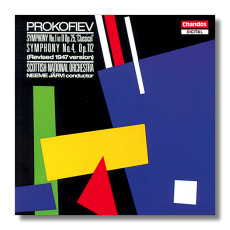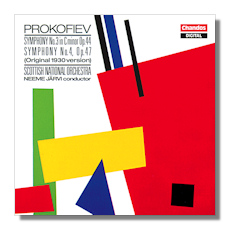
The Internet's Premier Classical Music Source
Related Links
- Prokofieff Reviews
- Latest Reviews
- More Reviews
-
By Composer
-
Collections
DVD & Blu-ray
Books
Concert Reviews
Articles/Interviews
Software
Audio
Search Amazon
Recommended Links
Site News
 CD Review
CD Review
Serge Prokofieff

Symphonies
- Symphony #1 in D Major "Classical", Op. 25 (1917)
- Symphony #4 in C Major, Op. 112 (1930, revised 1947)
Scottish National Orchestra/Neeme Järvi
Chandos CHAN8400 DDD 51:48


- Symphony #3 in C minor, Op. 44 (1928)
- Symphony #4 in C Major, Op. 47 (1930)
Scottish National Orchestra/Neeme Järvi
Chandos CHAN8401 DDD 59:08
There are two versions of the Prokofieff Symphony #4 – the Op. 47 (1930) and the substantially revised and enlarged Op. 47/112 (1947). Opinion among musicologists and critics has tended to favor the earlier work, but conductors have shown a marked preference for the expanded version in the both the concert hall and recording studio. In Prokofieff Symphony cycles, for instance, usually only the later score is featured, as in Weller/London, Kosler/Supraphon, Rozhdestvensky/Melodiya, Ozawa/DG, and (I believe) Kitaenko/Melodiya. The one set to offer only the Op. 47 is the Martinon/Vox. Both versions, however, are given in the Rostropovich/Erato and in the Järvi/Chandos discs under review here. There have been but two non-cycle recordings of the Op. 47/112 (Ormandy/Columbia in the 1960s – which somebody at Sony should have the good sense to re-release – and the recent DePreist/BIS) and only one (!) of Op. 47 (Georges Sebastian on, I believe, Vox, from ages ago).
In 1929 Serge Koussevitzky's Boston Symphony Orchestra commissioned Prokofieff, Stravinsky, Honneger, Hindemith, Hanson and others to write a work for the commemoration of the orchestra's fiftieth anniversary for the 1930-31 season. Prokofieff, freshly stung from missing a crucial deadline with the Städtische Oper in Berlin for his opera, The Fiery Angel (which cost him the opportunity of seeing the work staged in his lifetime), was not about to become a victim of the clock again. So, he began work in earnest in the fall of 1929 on his Symphony #4, and decided to fashion it after his quite successful ballet, The Prodigal Son, perhaps because he had no appetite to write such a work from scratch with another deadline hanging overhead. Though much of the music in the first movement was newly composed, a good deal of the rest relied heavily on the ballet. Moreover, the music is developmentally terse in its thematic abundance, and transitions are either abrupt or nonexistent. In short, the symphony often sounds as if it had been quickly pieced together to meet the commission deadline, though it was in fact finished in plenty of time. At its first performance on November 14, 1930, it was not a success.
Prokofieff later expressed an affinity for the work's wealth of ideas, though, and eventually got around to revising it. The new version increases in length by half over the original and turns its focus toward the epic, away from the subtle and somewhat subdued character of Op. 47. The result of Prokofieff's effort is a magnificent symphony: its opening is altogether new; the first-movement development is thoroughly reworked; and while most of the changes in the second and third movements have more to do with expansion of ideas rather than with the addition of new ones, the finale features a wholly new middle section and an extended coda which recalls the symphony's opening theme. There is a dramatic sweep to this version that is lacking in the earlier one. And while the Op. 47 may have a greater coherence in its compactness, the longer work, through thematic relationships among the movements and through an unveering musical trajectory of tension and struggle leading to bold gestures or resolving in grand climaxes, is ultimately more unified. I must say here that I am puzzled that so many musicologists favor the Op. 47 over its more grandiose sibling. They charge the later work is padded with beefed-up orchestration and note-spinning episodes. Sure, it might give the illusion of being "fat" alongside the comparatively "anorexic" original, but it's a finely crafted work, featuring many memorable melodies and distinctive harmonies all clothed in typical Prokofieffian instrumentation. Which is to say it's a great piece. And while the earlier composition is the lesser of the two, it has a stature of its own, and fully deserves more attention than it's received.
In both Fourths Järvi, certainly one of the top two or three Prokofieff conductors in the world, is right on target. He does not slight the shorter work's moments of massive sonority, but manages through lively tempos and rhythmic inflection to incline them toward a rowdy, good-humored demeanor, rather than toward the epic bigness he brings out in the later work. He understands the differences between the two works and consistently displays interpretive insight. Listen, for instance, to the Op. 47/112's coda (track 8; 6:32): Järvi imparts a sinister quality to the brass theme with staccato-like accents, making the build-up that climaxes in the powerful return of the opening theme even more effective. And listen to his sensitive phrasing of either symphony's slow movement: the lyricism breathes and inner details emerge to heighten the dramatic flow. And Järvi is abetted by the spirited Scottish National Orchestra and Chandos' powerful sonics.
Clearly he stands out above his competition in both versions. (I have not yet heard the Ozawa, though I suspect from reading at least one review that he won't surpass Järvi.) And in the couplings, the Classical Symphony and Symphony #3, he and his forces are again superb – elegant and not overly fleet in the former, gripping and powerful in the latter. In sum, both these discs are urgently recommended.
Copyright © 1997, Robert Cummings




















